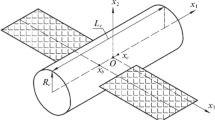Abstract
The solar orientation mode of an artificial Earth satellite is investigated. Satellite parameters correspond to the parameters of the Bion M and Foton M-4 satellites. In this mode, the normal to the satellite solar cell plane is always directed to the Sun, the longitudinal axis lies in the plane of the orbit, and the satellite absolute angular velocity is very small. The mode is stabilized by electromagnets that interact with the Earth magnetic field and a rotating flywheel that generates a constant gyrostatic moment along the satellite longitudinal axis. Such a moment can be generated using a reaction wheel system. The constancy of the gyrostatic moment means that this system will operate without saturation. The satellite attitude control is implemented by changing the currents in the electromagnets. Two control laws that reduce the satellite angular velocity and stabilize the solar orientation are investigated. Their implementation does not require complex measurements. It is sufficient to have the readings of a solar sensor and a triaxial magnetometer and equipment for their processing. The effectiveness of control laws is confirmed by the mathematical modeling of the satellite motion with respect to the center of mass under the influence of gravitational and aerodynamic moments, as well as the moment generated by electromagnets.










Similar content being viewed by others
REFERENCES
Beletskii, V.V., Dvizhenie iskusstvennogo sputnika otnositel’no tsentra mass (Motion of an Artificial Earth Satellite About Its Center of Mass), Moscow: Nauka, 1965.
Kovalenko, A.P., Magnitnye sistemy upravleniya kosmicheskimi letatel’nymi apparatami (Magnetic Aircraft Flight Control Systems), Moscow: Mashinostroenie, 1975.
Ignatov, A.I. and Sazonov, V.V., Realization of artificial Earth satellite rotation modes with small residual accelerations by electromechanical actuators, Preprint of Keldysh Inst. Appl. Math., Russ. Acad. Sci., 2008, no. 13.
Sazonov, V.V. and Troitskaya, A.V., Periodic motions of a gyrostat satellite with a large gyrostatic moment about the centre of mass, J. Appl. Math. Mech., 2015, vol. 79, no. 5, pp. 416–425.
Abrashkin, V.I., Puzin, Yu.A., and Sazonov, V.V., Electromagnetic satellite rotation control system with small residual accelerations onboard the satellite, Preprint of Keldysh Inst. Appl. Math., Russ. Acad. Sci., 2010, no. 22.
Ignatov, A.I. and Sazonov, V.V., Stabilization of the artificial Earth satellite gravity orientation mode by electromagnetic attitude control system, Preprint of Keldysh Inst. Appl. Math., Russ. Acad. Sci., 2016, no. 28.
ACKNOWLEDGMENTS
This work was supported by the Russian Foundation for Basic Research, project no. 17-01-00143.
Author information
Authors and Affiliations
Corresponding author
Additional information
Translated by O. Pismenov
Rights and permissions
About this article
Cite this article
Ignatov, A.I., Sazonov, V.V. Stabilization of the Solar Orientation Mode of an Artificial Earth Satellite by an Electromagnetic Control System. Cosmic Res 56, 388–399 (2018). https://doi.org/10.1134/S0010952518050015
Received:
Published:
Issue Date:
DOI: https://doi.org/10.1134/S0010952518050015




